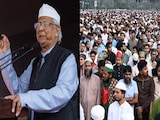Political instability in Bangladesh has disrupted its garment industry, impacting India's textile sector as well. India is one of the largest suppliers of cotton yarn and fabrics to Bangladesh, and many Indian companies have their garment manufacturing bases there. In light of the crisis, global buyers, along with Indian and foreign manufacturers, are exploring the possibility of shifting their business to India and other countries in Southeast Asia.
Approximately 25% of the manufacturing units in Bangladesh are owned by Indian companies. Both Indian and foreign companies with operations in Bangladesh are concerned about maintaining production flow, leading to delays and potential market shortages. There are also significant orders from major global brands, who are apprehensive about the situation.
This crisis presents an opportunity for India to capture market share as companies consider relocating their production bases. Reports indicate that orders worth billions of dollars from influential buyers in Europe and the USA have already been redirected to Indian textile companies.
Present Challenges
The textile and garment industries have been key drivers of growth in Bangladesh's rapidly developing economy, with their exports being the primary source of foreign exchange earnings.
Ready-made garments account for over 92% of Bangladesh's merchandise exports and more than 80% of its total exports. Last year, Bangladesh was the third-largest exporter of clothes, following China and the European Union (EU).
India has been a major exporter of cotton and synthetic fibres to Bangladesh, becoming a crucial raw material supplier for the country's booming textile industry.
Garment production in Bangladesh has been further hampered by severe flooding and electricity shortages this year. These challenges have unsettled global buyers and brands, prompting them to seek alternative destinations for their orders for the upcoming season. These brands are now evaluating various factories in India to ensure they meet global standards. Key garment export hubs in India, such as Tirupur in Tamil Nadu, Ludhiana in Punjab, Surat in Gujarat, Jaipur in Rajasthan, and Noida in Uttar Pradesh, stand to benefit. Indian garment exporters like Arvind Mills and Raymond are among the major beneficiaries of this shift.
However, to convert this temporary advantage into a lasting gain, India must quickly establish a favourable ecosystem by offering single-window clearances, incentives, and reducing bureaucratic complexities.
Rising Demand
Industry experts forecast growth for the readymade garment sector driven by domestic demand during festivals and weddings. India's RMG exports are expected to benefit from restocking by Western retailers, a general boost in retail sales, and changing geopolitical conditions. The sector will also gain from stable cotton prices and uninterrupted supply, enhancing its cost competitiveness globally.
Indian garment exports to the US have been gradually increasing, as major retailers diversify their supply chains under the China+1 strategy. The US now accounts for nearly 60% of India's textile exports. India's competitive advantage in raw material costs and increased domestic capacity is likely to sustain its dominance in the US home textiles market.
There is significant potential for India to gain more substantial market share as global buyers continue to diversify their supply chains away from Bangladesh. These buyers are concerned not only about the current disruptions but also about rising wages in Bangladesh and its impending loss of Least Developed Country (LDC) status by 2029. Although Bangladesh's graduation from the UN's LDC list in 2026 is a matter of national pride, it will also mean the country will lose access to certain international aid measures for LDCs. The EU and some countries, such as Canada, Australia, and the UK, have agreed to extend LDC-linked benefits for Bangladesh for an additional three years, until 2029.
To capitalise on this opportunity, India will need to align its product portfolios and trade agreements with those of Bangladesh or Vietnam, particularly through Free Trade Agreements with the UK and EU. Negotiating these terms will provide additional growth opportunities for India's textile and RMG sectors.
Nevertheless, India faces challenges such as outdated labour laws and high logistics costs due to inadequate infrastructure.
A recent Global Trade Research Initiative (GTRI) report indicates that India's textile exports decreased from $37.16 billion in 2018 to $34.24 billion in 2023, marking a decline of 7.87%. In 2023, India's garment exports totalled only $14.5 billion, significantly trailing behind China ($114 billion), the EU ($94.4 billion), Vietnam ($81.6 billion), and even Bangladesh ($43.8 billion). This is a concerning trend.
As China's and Bangladesh's dominance wanes, the world is searching for the next textile hub. India, with its rich textile heritage, vast labour force, and growing technological capabilities, is well-positioned to seize this opportunity.
The Indian government has demonstrated its commitment to revitalising the textile sector. The 2024 budget announcement by Finance Minister Nirmala Sitharaman allocated Rs 4,417.03 crore for the 2024-25 fiscal year—a 28% increase from the previous year. However, merely allocating funds will not suffice.
India needs to boost production and export of synthetic apparel to meet global demand. Like Bangladesh, India must import high-quality fabrics and yarns to produce competitive synthetic garments for Western markets. Investment in large-scale, technologically advanced weaving and processing units, innovation in textile technology, sustainable clothing practices, a skilled workforce, and simplified labour laws and compliance are critical to capitalising on this opportunity.
(The author is Contributing Editor, NDTV)
Disclaimer: These are the personal opinions of the author















